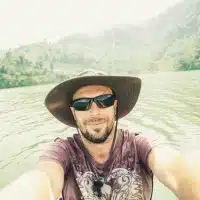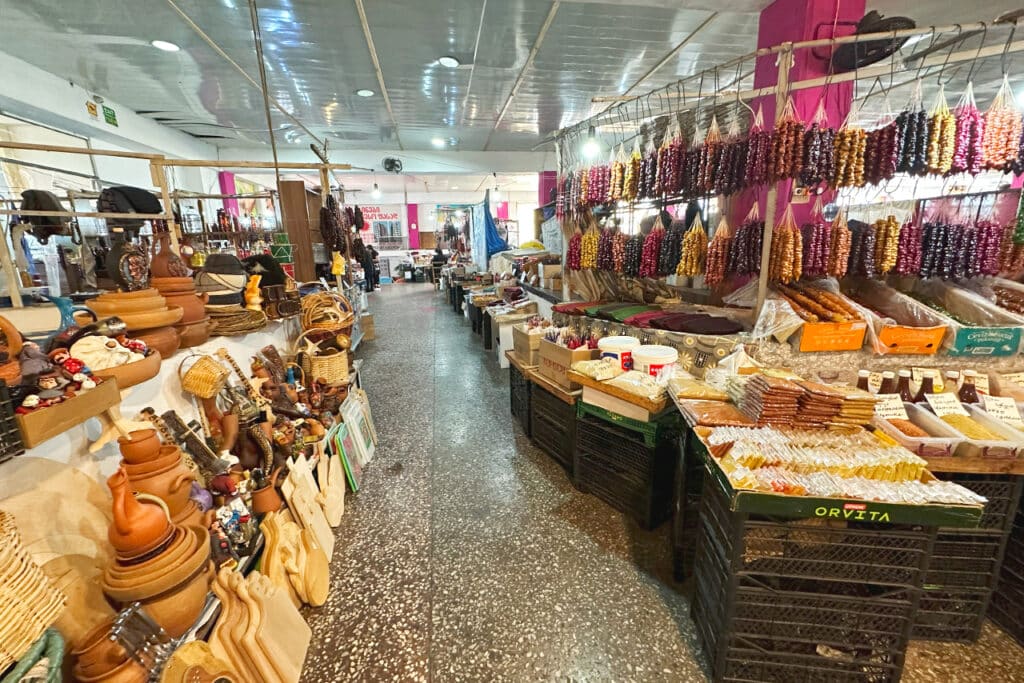Batumi Market: Operating Hours
The Boni Market operates every day except Monday, from 10:00 AM to 7:00 PM during the summer. In winter, it may close an hour earlier.
If you’re looking to save some money, visit Boni closer to closing time. Vendors often sell their goods at lower prices towards the end of the day, making it a great time to negotiate a better deal.
Boni Market Location and How to Get There
Address: Mayakovsky St. 4
PS: The street was recently renamed Saint Severian Achareli. Online maps know it by its old name, but if you can’t find it, look for the new one.
Coordinates: 41.643480, 41.654931
Landmarks: Old Bus Station, Batumi Oil Terminal
Boni Market is slightly off the main tourist paths. If you’re staying in the Old Town, you can reach it on foot in 20–30 minutes. If you’re near the New Boulevard, it’s better to take a taxi (about 5 GEL) or a bus. For public transport, you’ll need a transportation or bank card.
Bus Numbers: 1, 1a, 2, 2a, 4, 8, 12, 12a, 15, 16
You can also take a minibus—just ask the driver if it stops at the Boni market.
Locals typically refer to it as a “bazaar,” not a market, so ask for “Boni Bazaar” for clarity.
Walk the charming streets of the Old Town with our immersive English-language audio guide.
Start your tour
The indoor market has two floors, along with small pavilions and a large outdoor trading area. There is no strict separation of products, but here’s a general idea of what you’ll find:
First Floor: Meat, vegetables, fruits, greens, sauces, spices, and pickled goods

Second Floor: Churchkhela, nuts, honey, dried fruits, tea, coffee, chicken, pork and cheeses
There’s also a fish section, though we recommend visiting the dedicated fish market in Batumi instead.
– At the far end of the market, you’ll find small wholesale shops where many cafés and stores buy their supplies. Prices are often lower here than in city supermarkets.
– On Sesilia Takaishvili Street (across from the market), fruits and vegetables may be even cheaper, especially if you’re buying in bulk. The further you go from the market, the better the prices become, thanks to wholesale vendors.
You can also find seasonal produce like feijoa, mandarins, chestnuts, and persimmons grown locally in Adjara.
The Atmosphere of Boni Bazaar
Even before entering the market, you’ll encounter the vibrant spirit of street trade, with small stalls and vendors selling everything from food to clothing and souvenirs.
Inside, the market has a classic bazaar vibe. You’ll see large cuts of pork and beef being butchered on-site and brightly colored spices filling the air with rich aromas. Vendors often sprinkle water on fresh greens, making them glisten and inviting you to browse.
Expect to be called out to by vendors—inviting you to taste, bargain, and, of course, buy. If a seller doesn’t speak Russian, they’ll likely fetch a colleague to assist. Whether you purchase anything or not, you’ll find the merchants welcoming and friendly.
Interestingly, the market has become popular with Chinese tour groups, a sign of Boni Bazaar’s growing significance for Batumi and Adjara.
What to Buy at Boni Bazaar
Churchkhela: A must-buy Georgian delicacy made from nuts and grape juice. It’s long-lasting, easy to carry, and beloved by everyone.
Spices: No bazaar is complete without fragrant spices. Don’t miss the famous Svanetian salt! If you buy spices without factory packaging, use extra bags to avoid your luggage smelling like spices.
Tea: Loose-leaf tea here is unique. In addition to black and green teas, you’ll find fruit, berry, and floral blends made by local households. Blueberry tea and hibiscus are my personal favorites.

Fruits and Vegetables: Each month brings fresh seasonal produce straight from local farms. Even if you didn’t plan to buy any, you might not be able to resist!
Prices at the Batumi Food Market
Bargaining is part of the experience at Boni Bazaar. While you can accept the initial price, it’s often higher, especially if you stand out as a tourist. Some vendors may even be surprised if you don’t negotiate.
Here are some general price ranges for popular products:
Churchkhela: 2–3 GEL per piece
Suluguni Cheese: 12–20 GEL per kilogram
Tomatoes: 2–7 GEL per kilogram
Homemade Wine: 5–10 GEL per liter
Keep in mind that many vendors only accept cash, so bring enough local currency with you.
A Brief History of Batumi’s Bazaars
Batumi’s main bazaar has moved several times throughout the city’s history. In the early years, it was located on what is now Gorgiladze Street (formerly Bazaar Street). Today, that spot is a small park near the Art Museum.
There’s even a story that the writer Mikhail Bulgakov worked briefly at the market during his attempt to flee to Turkey. According to legend, he met his Margarita there.
In the late Soviet era, the market relocated near the port, where the “Plaza” shopping center now stands. For many locals, weekend trips to the market became a cherished family tradition, passed down through generations.
Recently, the market moved outside the historical center.
To clarify: Boni Bazaar, Parekhi Market, and the Central Market are all the same location.
Though modern supermarkets now offer fresh produce, shopping at Boni Bazaar provides a unique cultural experience. Buying homemade cheese from a friendly local feels much more personal than picking it off a store shelf.
And where else can you enjoy the vibrant sights, scents, and sounds of an authentic Georgian market, bargain for your favorite goods, and experience the charm of the East?
See You at Boni Bazaar, Friends!
More about Batumi and Georgia:
Best hotels in the mountains of Georgia
The Best Adjarian Khachapuri in Batumi. Top 5 Places
Shekvetili Dendrological Park (48 km from Batumi)

Hello!
I am Victor, the founder of this site and its main, but not the only author.
Traveler and photographer. Visited more than 40 countries.
Born and raised in Batumi. I love to travel in Georgia.
More about me here.





